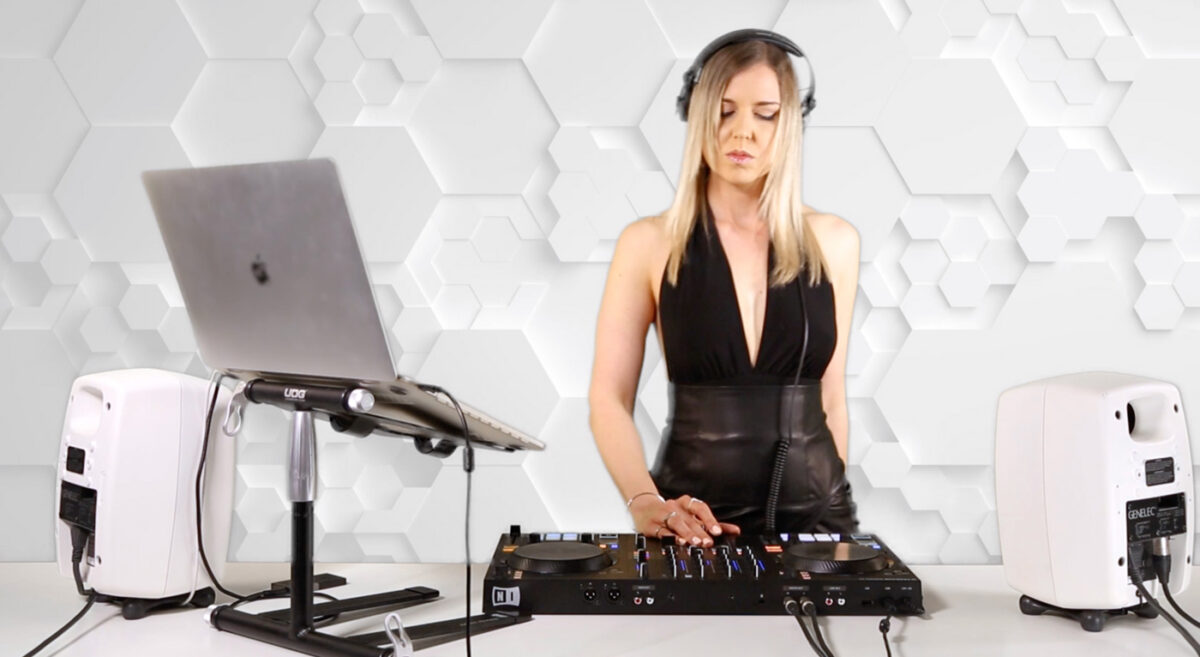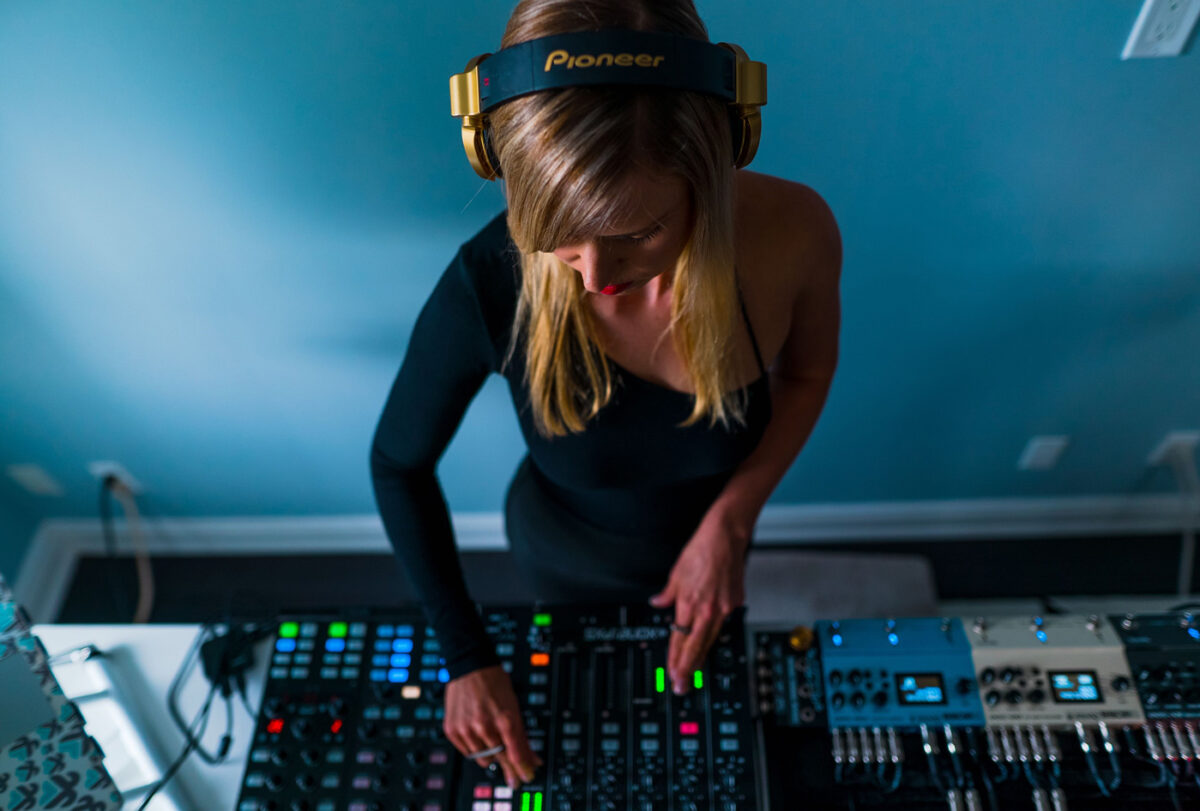
DJ transitions are the art of moving from one track to the next and keeping the flow of the music going. If you reflect on the best DJ sets you’ve seen or listened to, the DJ was likely able to move fluidly from one track to the next while maintaining a steady rhythm. Professional DJs use DJ transitions so the dancers on the dancefloor can keep moving to the beat, without feeling like their rhythm is off when the track changes.
In this blog, you’ll learn five basic transitions that you can use in your sets. When you combine together great tracks, strong music programming skills and the best DJ transitions, you’ll be able to play confidently to dancefloors, and create memorable sets and videos.
Jump to these sections:
Follow along using Traktor Pro, industry-leading DJ software that can help you create your best performances.
What are DJ transitions?
An effective DJ set requires well-executed transitions. Simply put, a DJ transition is the technique used by a DJ to change from one song to the next in a set. There are several basic techniques that are commonly used for transitioning between tracks. If you’re just starting out mixing, it’s recommended to master these five transition techniques.

Elements of DJ transitions
Let’s explore some of the essential elements that can help you learn how to make DJ transitions in your performances.
Counting the beats and bars in music
You’ll need to count the bars in each track, to understand the track’s structure and discern where the appropriate parts to mix in and out are. Most dance music and urban tracks have four beats in a bar, and tracks are arranged in eight bar sections. Press play on a track, start at beat one, and count the beats. In each new bar, count the bar number, up to eight bars and then repeat again. Eg. 1, 2, 3, 4 / 2, 2, 3, 4 / 3, 2, 3 4, etc. The very first beat in a bar is called ‘the downbeat’, and it always occurs on beat one.
Beatmatching
The majority of mixes DJs create are beatmatched. If you are mixing together two songs with similar bpms, choose tracks that are within five bpm of one another. If you are beatmatching by ear, use the pitch fader in Traktor, or on your DJ controller or player to match the tempo of the track you’re mixing in with the track that’s currently playing. If you’re using Traktor, you can use the Sync feature for quicker beatmatching. When using Sync, you’ll need to be sure that each track’s beat grids are aligned correctly. To learn more about basic DJ techniques, check out our guides on how to become a DJ and DJing with Traktor.
Phrasing
Mixing one track into the next will work more seamlessly if the two tracks are aligned using the track’s song structure. This means you’ll need to know the arrangement structure of each track, which includes sections like the intro, main beat or verse, buildup, breakdown, drop or chorus and outro. Phrase mixing is using the track’s song structure as a guide to learn where good places to mix in or out of a track are. Using phrasing helps a DJ to mix in a way that’s more natural for listeners, and create impactful transitions that make musical sense.
Harmonic mixing
Harmonic mixing includes using the key of each song to create a mix that’s harmonically compatible, and sounds good. Mixes that are out of key have a clashing or dissonant sound. To mix in key, simply read the song’s numeric or alphanumeric key, and use the key system to mix. Alternatively you can analyze your tracks using Mixed In Key and use the Camelot Wheel to choose tracks that will sound good together.
Cueing and monitoring
A DJ controller or mixer allows you to listen to the upcoming track you’re going to play in your headphones. You’ll need to use the cue button on your DJ controller, in Traktor or on a DJ mixer to listen to the track you’re going to mix in. A monitor (speaker) that’s close to your DJ setup will allow you to hear the track that’s playing and listen attentively to your DJ mixes. For more details about the equipment you need to complete your DJ setup, check out our DJ equipment guide.

Basic DJ transitions
The type of transitions you use in your sets will depend on the style of music you play. Techno and house DJs tend to prefer mixing with smooth transitions to create seamless blends and will often embellish their sets with effects in Traktor. Hip hop, drum’n’bass, open format and urban DJs tend to use shorter mixes, cut in tracks ‘on the one’ (the downbeat) and incorporate techniques like scratching and juggling.
1. The fade
This is a smooth type of mix, where one track fades in as the other fades out. Note that the two tracks you use do not need to be the same bpm, so you can use this technique to switch genres or tempos.

- Start by loading in a track in Traktor in Deck A, and analyzing the track’s structure to find a part in the track that you can use to transition into the next song. This could be the end of the first chorus, or the instrumental outro of the track.
- Use a cue point in Traktor to mark this spot. Start the track from the beginning and bring the channel fader of this track down at the cue point.
- At the same time, play the next track in Deck B, beginning on beat one of a bar (the ‘downbeat’) so that the second track comes in as the first track in Deck A fades down.
Tracks:
Disfreq – “Turn Off”
Sara Simms & Adam James – “Regenerate”
2. The cut
The cut involves quickly changing from one track to the next on a downbeat and using the volume faders or the crossfader for a fast transition.

You will need to know the song structure of each track, and count the bars.
- On Deck B in Traktor, start by setting a cue point on the second track (the track you’ll mix in) on the ‘downbeat’, beat one of a bar.
- Play a track in Deck A, count the bars and beats and find a place to mix out of, for example, the end of a chorus or drop.
- Release the second track on the downbeat, and use the crossfader to cut quickly all the way to the right so that only Deck B is playing.
- Alternatively, quickly bring up the channel fader of Deck B at the same time as you bring the channel fader of Deck A down.

Note: If you are using the crossfader in Traktor or on a DJ controller for cut mixes, be sure that the crossfader is set to the correct position.
In Traktor, in the Mixer mode view, you can assign the crossfader to one or more decks. On a DJ controller or mixer that has a crossfader selector switch, select the position that looks like a table, not an x.
The ideal crossfader position for cut transitions is when the crossfader is on the far left only Deck A plays, and when it is on the far right, only Deck B plays.

Tracks: Calvin Pepper – “In My Bed” (Simmetry Sounds)
Matt Sassari, Hugel, Cumbiafrica – “El Sueno” (Matt Sassari Edit- Extended)
3. Single phrase beatmatch
Using the single phrase beatmatch transition, you’ll be beat matching the tracks, but not making any changes to the EQ on the mixer.

- Start by choosing two tracks that are in a similar bpm range (within five bpm of each other) and ideally in compatible keys.
- In Traktor, play the first track on Deck A. Load up your next track on Deck B, and bring the Channel fader of Deck B down so it doesn’t play through the master output.
- Press the Cue button on Deck B to listen to your track in the headphones. Press Sync on Deck B to sync the BPM of the track to Deck A or use the pitch fader on your DJ controller to beat match.
- Go back to Deck A and find the section of the track you’d like to use to mix the second track in, and mark it with a cue point.
- Next, play the track on Deck A from the beginning. The easiest way to learn this transition is by using the outro section of track one, and the intro of track two.
- Sixteen or thirty two bars before the outro of the track in Deck A, press play on Deck B and slowly bring up the channel fader so that the two tracks play together, perfectly mixed.
Tracks: Tracks: Eli Brown – “Deep Down”
Noemi Black – “With You (Original Mix)” (Kuukou Records)
4. Bass swap transition
The bass swap transition is when the bassline of one track is swapped for the second bassline on the incoming track. The reason this is an effective mix transition is because the low frequencies in the bass is the most common area that tends to get ‘muddy’ in a mix and can make a mix sound cluttered. By swapping the basses, you can effectively clean up a mix.

- Beatmatch your tracks, and while the first track is playing in Traktor’s Deck A in the mix, turn down the Low EQ on Deck B in Traktor or on your DJ controller before bringing this track into the mix.
- When the two tracks are playing together, turn up the Low EQ on Deck B as you turn down the Low EQ on Deck A.

Tracks: Simina Grigoriu – “Raw Sugar” (Kuukou Records)
Sophia Sigma – “Machine Hearts” (Simmetry Sounds)
5. Filter fade transition
A filter fade transition can be used to mix two songs together that are very busy, and have a lot of elements in them. This transition is similar to the bass swap technique, except filters in Traktor or on a DJ controller or mixer are used.

- On Deck A, start your track, and use your headphones to match the key key, beatmatch, and phrase match your next track.
- On a Traktor DJ controller, use the Filter in the Filter FX section (button number one) and turn it on for both Deck A and B. On Deck B, turn the Filter knob all the way to the right, which turns on a high pass filter, cutting the low end of the track out.
- At your desired mix point, bring up the volume fader on Deck B and gradually turn the Filter knob on Deck B counter clockwise towards the center position, as you turn the Filter knob on Deck A counterclockwise.
- With Deck A’s Filter turned all the way to the left, fade down the channel fader on Deck A as Deck B plays with the Filter knob in neutral position, at 12 o’clock.
Depending on the content in the tracks, you may need to reverse the direction of the filter movements during the transition. Experiment and see what sounds best in your mix!

Tracks: Joel Demoor – “Fractured Voices”
Boys Noize, Skrillex -“Fine Day Anthem” (Extended Mix)
Start practicing your transitions today
Well executed DJ transitions will make your mixes sound incredible for your listeners and audience. Get started by using Traktor Pro and your favorite DJ controller to practice your transitions. If you fuse together great music and master these five DJ transitions, you’ll be well equipped to create demos and mixes, and keep the crowd on your dancefloor moving all night long.















